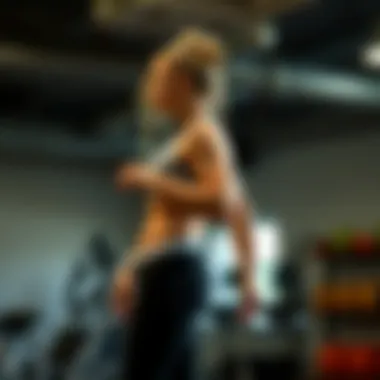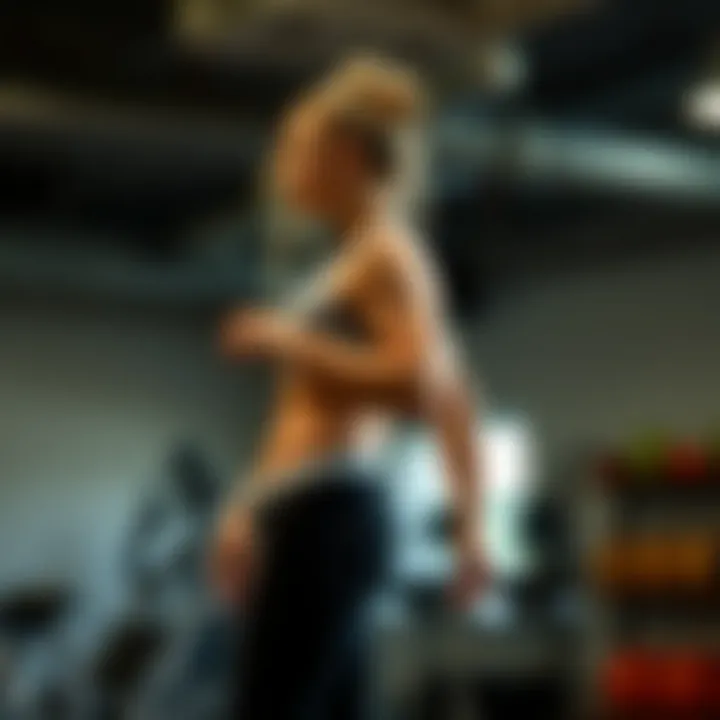Targeted Workouts to Eliminate Belly and Thigh Fat


Intro
In today’s fast-paced world, tackling belly and thigh fat is a quest that many embark upon, seeking both aesthetic and health improvements. While appearances might motivate individuals to engage in workouts, the underlying benefits extend well beyond looking good. Understanding what truly drives fat loss, particularly in these stubborn areas, involves a multifaceted approach that encompasses exercise, nutrition, and mindset. This guide dives headfirst into the heart of effective workouts designed specifically to target these regions, paving the way for a healthier and stronger body.
Key Benefits
Physical Health Benefits
Burning fat in the belly and thigh areas contributes significantly to physical well-being. Excess fat in the abdominal region is often linked with various health concerns, such as diabetes, heart disease, and hypertension. Engaging in workouts that burn fat helps reduce these risks.
- Enhanced cardiovascular health arises as a effect of regular, vigorous exercise, improving heart function.
- Increased muscle strength and endurance are byproducts of consistent training routines that focus on high-intensity workouts.
- Boosting metabolism is an additional benefit, aiding the body in burning calories more efficiently, which can facilitate weight loss over time.
Mental Well-being Enhancements
It's not just the body that reaps the rewards; shedding unwanted fat also nurtures mental health. The connection between physical activity and mental clarity is profound. With an uptick in endorphins, one may experience a greater sense of happiness, reduced anxiety, and improved focus. Additionally, winning small fitness battles can bolster self-discipline and confidence. Regular workouts can also lead to improved sleep, thereby enhancing overall well-being.
"Physical activity has a way of lifting not only the body but also the spirit."
Practical Tips
Effective Meal Planning
Nutrition plays a pivotal role in accentuating the results of any workout routine. It is important to consider meal planning carefully:
- Whole Foods: Opt for unprocessed foods packed with nutrients. Think bright fruits and veggies, whole grains, and lean proteins.
- Protein Pairing: Incorporating protein with every meal can help you feel full longer, thus curtailing impulse snacking.
- Hydration: Never underestimate the power of water. Keeping hydrated supports metabolism and aids in fat loss.
Quick and Efficient Workouts
Time is often an enemy in the pursuit of fitness. Here are strategies to maximize workouts even on a tight schedule:
- High-Intensity Interval Training (HIIT): Short, intense bursts of exercise followed by rest periods yield results in minimal time. Consider exercises like burpees, sprints, and high-knees.
- Circuit Training: Rotate through various exercises with minimal rest. This keeps the heart rate up while targeting multiple muscle groups, aiding in fat loss.
- Bodyweight Workouts: Not always needing fancy gadgets, utilizing body weight exercises, like lunges and planks, can be done anywhere and anytime.
Incorporating these aspects into a dedicated routine will undoubtedly yield positive outcomes. Consistency is key, and as with any journey, patience and perseverance will carve the path to success. For further information on dietary science and fat loss strategies, consider exploring resources from reputable health domains, such as NHS or Centers for Disease Control and Prevention.
Ultimately, by marrying strategic workout methodologies with nutritious meal planning, individuals can effectively target belly and thigh fat, carving out a more resilient and energetic version of themselves.
Understanding Fat Loss
Understanding fat loss is a critical foundation for anyone looking to effectively target and reduce fat around the abdomen and thighs. This comprehensive focus delves into the biological mechanisms and external factors that contribute to how our bodies store and burn fat. Recognizing these elements can empower individuals to make informed choices on their fitness journeys.
The Biology of Fat Storage
Fat storage in the body is not as simple as just eating too much. It involves a complex interplay of hormones, cells, and lifestyle factors. When calories consumed exceed calories burned, the excess energy is stored as triglycerides in adipose tissue. This process is primarily regulated by hormones like insulin, which promotes fat storage, and glucagon, which facilitates fat release. Additionally, different types of fat—subcutaneous fat found just under the skin and visceral fat located deeper around internal organs—play unique roles in our health and fat-loss journey.
"Understanding where fat is stored can guide targeted strategies for reducing belly and thigh fat."
These biological processes can be influenced by genetics, age, and even gender, with some individuals genetically predisposed to store fat in particular areas. For instance, many women tend to store fat more in their thighs and hips, while men often find belly fat is their primary concern. Recognizing these patterns can shape personalized fitness plans.
Factors Influencing Fat Distribution
Fat distribution is not uniform across individuals, and several factors contribute to this variance. Hormones, especially estrogen and testosterone, dictate where fat is stored. For example, high estrogen levels often lead to increased fat storage in the hips and thighs, while testosterone tends to favor visceral fat accumulation in the belly region. Lifestyle elements such as diet, physical activity, and stress also affect where fat is deposited.
- Diet: A diet high in refined sugars and unhealthy fats is linked to increased visceral fat.
- Exercise: Regularly engaging in aerobic and strength training can help shift body composition towards leaner muscle.
- Stress: Elevated cortisol levels due to stress can lead to increased abdominal fat.
Understanding these influences can lead to more effective workout strategies designed specifically to address belly and thigh fat.
The Role of Metabolism in Fat Loss
Metabolism plays an essential role in fat loss. It encompasses all the chemical processes that convert food into energy. A faster metabolism means that the body burns calories more efficiently, which can help in reducing fat.
There are two main components of metabolism: basal metabolic rate (BMR), the energy your body expends at rest, and activity thermogenesis, which includes calories burned through exercise and daily activities. A higher muscle mass increases BMR, leading to greater fat loss potential.
Incorporating strength training into a workout regime is pivotal as it helps build muscle, thereby boosting metabolism. This means that even when at rest, the body is more effective at burning fat for energy. Consistency in managing one's calorie intake in conjunction with an appropriate exercise regimen creates a state of caloric deficit, essential for losing fat effectively.
In summary, grasping how fat is stored, the various factors impacting distribution, and the vital role of metabolism lays the groundwork for targeted strategies to tackle belly and thigh fat. The next sections will explore practical workouts that apply these principles.
The Target Areas: Belly and Thigh Fat
When it comes to fat loss, understanding the specific areas that often resist efforts is essential. Belly and thigh fat are two of the most notable problem areas for many people. They hold significant influence over a person’s physical appearance, often impacting both self-esteem and overall health. Focusing on these target areas not only helps with aesthetics but also alleviates common health complications associated with high fat deposits around the abdomen and thighs. This article will dive into why these parts of the body can be stubborn when it comes to fat loss, and how tailored workouts can help.
Identifying Problem Areas
Recognizing where excess fat gathers is the first step in crafting an effective workout strategy. For many individuals, belly fat tends to be the first noticeable sign of weight gain. It is primarily classified into two types: visceral and subcutaneous fat. While both can be concerning, visceral fat has a more significant impact on health as it surrounds vital organs. On the other side, thigh fat is usually more subcutaneous, sitting just under the skin.
Various factors can contribute to the accumulation of fat in these areas:
- Genetics: Some people are predisposed to store fat in the belly or thigh regions.
- Hormones: Fluctuations in hormones, especially during menopause, can lead to changes in body composition.
- Lifestyle Factors: Sedentary behavior or poor dietary choices can exacerbate the issue.
Understanding Body Composition
Gaining a clear insight into body composition helps in understanding fat distribution. A body composition analysis typically reveals the ratio of fat to lean mass, which directly relates to where fat is stored. Tools such as bioelectrical impedance analysis (BIA) can offer insight into one’s fat levels.
Focusing on body composition rather than just scale weight can foster a healthier approach to fitness. Here’s why:


- Informed Decisions: Knowing body composition aids in shaping personalized workout plans.
- Measure Progress: Tracking changes in fat percentage can be more motivating than just focusing on weight.
- Health Benefits: Improved body composition often leads to decreased risk of chronic diseases, such as diabetes and cardiovascular diseases.
In summary, understanding why belly and thigh fat can be more pronounced and how body composition plays a role in these areas is critical for strategizing effective workouts. The focus now shifts towards actionable workouts that directly target these stubborn fat reserves, setting the stage for more rounded health and fitness improvements.
Workout Principles for Fat Reduction
When it comes to shedding excess fat, understanding the principles behind effective workouts is essential. Recognizing how different exercise modalities work, alongside personalizing a routine, can yield optimal results for those looking to tackle stubborn belly and thigh fat. By combining various types of workouts and adhering to well-defined principles, individuals can enhance their overall effectiveness in burning fat and improving their body composition.
High-Intensity Interval Training
High-Intensity Interval Training (HIIT) has taken the fitness community by storm, and for good reason. This approach involves short bursts of intense exercise followed by brief recovery periods. The beauty of HIIT lies in its ability to maximize fat burning in a shorter time frame compared to traditional steady-state cardio. Studies have shown that HIIT can lead to an increased metabolic rate post-exercise, commonly referred to as the afterburn effect.
Exercises can vary from sprints to jumping jacks, or even body-weight movements like burpees. The key is to push yourself during the high-intensity periods, really getting your heart rate up. This not only helps in losing belly fat but also targets those troublesome thigh fat stores. Consider a simple HIIT workout structure:
- Warm-up (5 minutes)
- 30 seconds of maximum effort (like sprinting or jump squats)
- 30 seconds of rest or light activity
- Repeat for 15-20 minutes
For those new to exercise, starting with moderate intervals may suffice and can be gradually adjusted.
Strength Training Basics
Strength training is another pivotal piece in the fat reduction puzzle, often overlooked by those trying to slim down. Lifting weights or doing resistance exercises boosts lean muscle mass, which in turn ramps up the body's resting metabolic rate. This means that the more muscle you have, the more calories you burn at rest.
Creating a balanced strength training routine includes a variety of movements that target all major muscle groups. Here are some tips to consider:
- Compound Movements: Exercises like squats, deadlifts, and bench presses engage multiple muscle groups, providing a more comprehensive workout.
- Frequency: Aim for at least two to three strength training sessions per week.
- Incremental Increases: As you grow stronger, increase weights or resistance gradually to stimulate muscle growth and further enhance fat burning.
Flexibility and Recovery
While it might not seem directly linked to fat loss, flexibility and recovery play an equally critical role in any effective fat loss program. Engaging in stretching and mobility work keeps muscles long and pliable, which can improve overall performance during workouts.
Moreover, giving your body adequate time to recover will prevent injuries, ensuring long-term success in your fitness journey. Consider incorporating the following:
- Dynamic Stretching: Ideal for warming up before workouts, such as leg swings or lunges.
- Static Stretching: Effective for cooldowns and improving flexibility. Hold stretches for 20-30 seconds.
- Rest Days: Ensure you have rest days in your schedule to allow your body to repair itself, particularly after intense workouts.
Quote: "Recovery is just as important as the workout itself. Balance is key to sustainable fat loss."
Effective Workouts for the Abdomen
Focusing on effective workouts for the abdomen is crucial in any fitness journey. The abdominal area not only plays a key role in overall body strength but also significantly contributes to posture and movement efficiency. When individuals work to reduce belly fat, they are not just aiming for aesthetics; they are also enhancing their overall health. Excess belly fat, linked to various health concerns like heart disease, diabetes, and certain cancers, emphasizes the necessity of targeted workouts.
In this section, we will delve into key exercises designed to strengthen and tone the core, as well as engaging cardio workouts tailored for burning belly fat. Understanding the right routines ensures that efforts are balanced and effective, paving the way for sustainable results.
Core Strengthening Exercises
Planks
Planks are a cornerstone of core strengthening. This exercise targets not just the abdominal muscles but also engages the shoulders, back, and legs. The key characteristic of planks is their isometric nature; you hold your body in a straight line, which requires enduring strength rather than quick bursts of energy. This makes them a particularly beneficial choice for overall core stability.
One unique feature of planks is their ability to build endurance as opposed to just isolating muscle groups. They improve overall body coordination and require no equipment, making them accessible in any setting, from a studio to a small living room. However, beginners might find maintaining proper form challenging, leading to poor alignment if not monitored.
Russian Twists
Russian Twists are particularly effective for targeting the oblique muscles. This rotation involves engaging the core while twisting the upper body side to side, which can enhance balance and coordination. They are popular for their dynamic nature, allowing practitioners to feel the distinction between various core muscle groups in action.
What sets Russian Twists apart is their scalability; they can be performed with or without weight, accommodating both novices and seasoned fitness enthusiasts. One downside is that too rapid a movement can lead to strain, emphasizing the need for a controlled pace during execution.
Leg Raises
Leg Raises are a fantastic exercise specifically targeting the lower abdomen. What stands out with this move is that it isolates the lower abdominal muscles, which can often be a stubborn area in fat loss. Noted for their simplicity, they require no additional equipment, fitting neatly into a home workout routine.
However, leg raises can challenge your hip flexors, so individuals must ensure that they are using their core properly to minimize strain. Paying close attention to form will amplify the benefits, ensuring effective engagement of the target area without overcompensation from adjacent muscle groups.
Cardio Workouts for Belly Fat
Running
Running stands out as one of the most effective cardio workouts for burning belly fat. The act of running engages multiple muscle groups while elevating the heart rate, which is essential for fat loss. Its key characteristic is that it’s an excellent option for high-intensity intervals, allowing individuals to switch between a steady pace and sprinting intervals.
The unique aspect of running lies in its accessibility; whether on a treadmill or a scenic route, anyone can participate. However, it can be hard on the joints, particularly for those with prior injuries or excessive weight; therefore, proper footwear and technique are essential.
Cycling
Cycling, whether stationary or outdoor, is another formidable ally in the fight against belly fat. Its primary advantage is that it is low-impact, making it easier on the joints compared to running. This exercise effectively builds endurance and strengthens lower body muscles while also elevating heart rate.
A unique feature of cycling is the wide range of options it offers; from leisurely rides to high-intensity spin classes, individuals can easily customize their workouts. One downside is that it may not be as engaging for some, especially when done solo without variation.
Jump Rope
Jump Rope is often overlooked but is extremely effective for burning calories rapidly. This workout targets the whole body, while cardio sessions focus on losing fat, particularly from the belly area. A key characteristic of jump rope is its ability to elevate heart rate quickly and promote coordination.
The major advantage here is that it is inexpensive and can be performed virtually anywhere, making it accessible to a broad audience. However, it does require a certain level of skill and rhythm, which may necessitate some practice for beginners to avoid frustration and injury.
Targeted Workouts for Thigh Fat
Targeted workouts for thigh fat are vital when working towards a leaner body and more defined contours. Many people, especially women, struggle with excess fat in their thighs, which can be stubborn and difficult to eliminate. Understanding and implementing specific exercises can not only enhance thigh appearance but also improve overall strength and fitness. It's about building strength and increasing metabolism, two key aspects that contribute to effective fat loss.


Lower Body Strength Exercises
Squats
Squats stand out as a core exercise for anyone aiming to hone in on thigh fat loss. The pressing action involved engages the quadriceps, hamstrings, and glutes significantly. One of the primary reasons why squats are such a go-to exercise is their versatility; they can be performed with body weight or added resistance, making them adaptive for any fitness level. The unique feature of squats is the compound movement pattern which shines in maximizing muscle engagement and caloric expenditure. A key advantage of squats is their functionality in everyday motions, promoting better balance and stability. However, improper form can lead to knee strain, so it's essential to maintain proper alignment.
Lunges
Lunges are another exceptional variant for thigh targeting due to their unilateral nature. This means that each leg works independently, which promotes muscle symmetry. Lunges place emphasis on various muscle groups within the thigh, including the quadriceps and glutes. The standout feature of lunges is their ability to engage core stability as you hold your balance and control throughout the movement. This exercise commands a full range of motion, enhancing overall leg strength while also torching calories. Nevertheless, lunges can be challenging for those with previous knee injuries or instability, thus careful execution is crucial.
Deadlifts
Deadlifts are often misinterpreted as purely back exercises; however, their impact on thigh and lower body strength is profound. This movement primarily engages the posterior chain, which includes the hamstrings and glutes, vital for reducing overall thigh fat. The beauty of deadlifts lies in their capacity to enhance overall functional strength and posture. They are particularly beneficial for building muscle mass, which is critical as muscle burns more calories at rest compared to fat. One disadvantage, though, is that deadlifts require proper form and technique to avoid injury, especially on one’s back.
Cardio Options for Thigh Fat Loss
Stair Climbing
Stair climbing is a functional form of cardio that can significantly help in reducing thigh fat. This exercise involves using large muscle groups, thus boosting heart rate and maximizing calorie burn. The key aspect of stair climbing is the elevation it offers, making it a higher intensity workout compared to level ground cardio. As a bonus, stair climbing tones the glutes and thighs effectively. However, it can be hard on the knees, especially for those with pre-existing joint issues, so moderation is advised.
Jump Squats
Jump squats take traditional squats a step further by adding a plyometric component. This explosion in movement not only builds muscle but also turns this exercise into a fat-burning powerhouse. The vigorous lifting action targets thighs while also enhancing cardiovascular fitness. The unique feature of jump squats is their capability to elevate metabolic rate post-exercise, leading to calorie burning long after the workout. A potential con is that they require a certain level of fitness and can be taxing on the joints if not executed well.
High Knees
High knees provide a rapid-paced cardio option that brings the focus back to the thighs while also engaging the core. This exercise is valued for its simplicity—almost anyone can do it, and it can be performed anywhere. High knees elevate heart rate effectively and serve as a great warm-up or conditioning drill. The unique benefit of high knees is their potential to improve agility and coordination. However, they might not be suitable for those new to fitness as the high impact may pose risks of injury without proper warm-up and conditioning.
Engaging in these targeted workouts can result in noticeable changes in thigh fat over time, provided these exercises are complemented by a well-rounded diet and overall activity. Consistency is the secret sauce to achieving your body goals.
Creating a Balanced Workout Plan
Creating a workout plan that effectively targets belly and thigh fat goes beyond just picking a few favorite exercises. It requires careful consideration of various factors to ensure you not only burn fat but also maintain overall health and fitness. A balanced workout plan integrates strength training, cardio, and flexibility work, aligning with your personal fitness goals. This multifaceted approach can enhance results, prevent injury, and facilitate adherence to your program.
The benefits of a balanced workout plan are myriad. For one, it promotes muscle retention, allowing you to lose fat while preserving lean muscle mass. A crucial point is that muscle burns more calories at rest, which can aid in maintaining a healthy weight long-term. Additionally, by incorporating different types of workouts, you can reduce the monotony that often leads to decreased motivation.
Several considerations come into play when constructing a balanced workout plan. Individual preferences, current fitness levels, and specific goals should guide your choices. It's essential to strike a balance between challenging yourself and ensuring your workouts remain enjoyable and attainable.
"Workout plans should be as diverse as your fitness journey. Mixing things up keeps you engaged and progressing."
Combining Different Workout Types
Combining various workout types is vital for both fat loss and general wellbeing. There are three main types to incorporate: strength training, cardiovascular exercises, and flexibility routines.
- Strength Training: This builds lean muscle mass, which is crucial for metabolism and aids fat loss. Exercises like squats, lunges, and deadlifts are not just beneficial for toning thighs but also help engage the core, giving a solid workout for multiple areas.
- Cardiovascular Exercises: Adding cardio sessions like running or cycling helps elevate heart rates, promoting calorie burn. High-Intensity Interval Training, or HIIT, can be particularly effective, providing a time-efficient way to torch calories.
- Flexibility Work: Often overlooked, incorporating stretching and yoga not only improves mobility but also aids recovery, preventing injuries that could interrupt your workout routine.
It’s important to rotate these types within your weekly schedule. For example, your plan could consist of strength training on Mondays, Wednesdays, and Fridays, while dedicating Tuesdays and Thursdays to cardio, with flexibility work sprinkled in during cooldowns or rest days.
Setting Realistic Goals
Setting realistic fitness goals is perhaps one of the most significant elements of a balanced workout plan. Goals should be specific, measurable, achievable, relevant, and time-bound (SMART). This framework helps maintain focus and directs your efforts in a constructive manner.
For instance, instead of a vague goal such as "I want to lose weight," try setting a goal like "I aim to reduce my waistline circumference by two inches in three months." Such a goal is clear and doable.
The pathway to achieving fitness goals using this framework requires smaller milestones. Celebrate every step in your progress, no matter how small. You might want to focus on increasing your weights or the number of reps in strength workouts, or perhaps aim to run an extra half-mile on cardio days.
Combining different workout types with clear, realistic goals creates a synergy that enhances your fat loss journey. This tailored approach means you’re more likely to stick to this plan and, importantly, enjoy the process of getting fitter.
For further reading on workout plans and fitness strategies, check out Wikipedia Fitness and Academy of Nutrition and Dietetics.
Nutritional Aspects of Fat Loss
When diving into the realm of fat loss, especially with the focus on troublesome areas like the belly and thighs, nutrition can't be thrown out the window. It's not just about a sweaty workout; what goes in your body plays a crucial role in sculpting that physique. A balanced approach to nutrition lays a strong foundation for any fitness endeavor. This section will unravel the essentials of caloric balance and macronutrients, painting a clearer picture of how each plays into the grand scheme of fat loss.
Understanding Caloric Deficit
At the center of fat loss lies a fundamental concept: caloric deficit. Simply put, to shed pounds, one must consume fewer calories than what the body burns. This principle forms the backbone of any weight loss strategy. However, the journey isn’t simply about slashing calories. It involves smart choices—prioritizing nutrient-dense foods that sustain energy while encouraging fat reduction.
Key Factors in Caloric Deficit:
- Assessing Basal Metabolic Rate (BMR): Knowing how many calories your body needs at rest is crucial. This figure allows one to establish a baseline and plan accordingly.
- Activity Level: Daily activities, workouts, and even minor movements contribute to the total calories burned. Thus, tailoring dietary intake according to lifestyle is important.
- Sustainable Approach: Drastic calorie cuts aren't just impractical; they can lead to deficiencies and metabolic slowdown. Gradual changes, aiming for a deficit of about 500 calories per day, can promote healthy weight loss without sacrificing wellbeing.
Macronutrients to Focus On
In the realm of nutrition, macronutrients—proteins, carbohydrates, and fats—serve different yet equally important roles. Each should be harmonized to optimize fat loss efforts.
Proteins
Consider proteins the building blocks of muscle. When aiming for fat loss, increasing protein intake can be beneficial. Why? Because protein has a higher thermic effect than fats and carbs, meaning more energy is expended digesting it. This can lead not only to fat reduction but also to lean muscle preservation.
Key Characteristics of Proteins:
- Muscle Maintenance: Higher protein intake can help maintain muscle mass while losing fat, which is especially important during any calorie deficit.
- Fullness Factor: Protein-rich foods can help one feel satiated longer, reducing the temptation to snack on less healthy options.
On the downside, not every protein source is equal. Processed meats, for instance, come with additives that can sidetrack fat loss goals. Opt for lean cuts, legumes, and plant-based options whenever possible.


Carbohydrates
Carbs often take a lot of flak in discussions about fat loss, but they shouldn't be vilified. The right kinds of carbohydrates are vital to fueling workouts and daily activities. Whole grains, fruits, and veggies provide energy and fiber, which can help keep hunger pangs at bay.
Key Characteristics of Carbohydrates:
- Energy Provision: They’re the primary energy source for the body, especially during high-intensity workouts that target fat loss.
- Nutrient Density: Whole foods rich in carbohydrates often come packed with vitamins, minerals, and antioxidants.
However, it's wise to avoid excess refined sugars and overly processed carb sources, which can lead to spikes in energy followed by crashes, derailing progress.
Fats
Fats have gained a better reputation over the years; they're essential for hormone production and nutrient absorption. The key lies in consuming healthy fats, like those found in avocados, nuts, and olive oil.
Key Characteristics of Fats:
- Satiety: Fats take longer to digest and thus can keep one feeling full longer.
- Nutrient Absorption: Certain vitamins (A, D, E, and K) require fat for absorption; without it, their benefits could be lost.
It's important to remain cautious of the types of fats consumed. Trans fats, often lurking in processed foods, should be avoided at all costs due to their detrimental health effects.
In summary, a balanced intake of macronutrients tailored to individual needs plays a crucial role in effectively burning belly and thigh fat. Understanding caloric deficits, along with prioritizing proteins, healthy carbohydrates, and beneficial fats, sets the stage for successful fat loss.
To further enhance your insights into nutrition, consider visiting Nutrition.gov or ChooseMyPlate.gov for comprehensive guidelines.
Lifestyle Factors Influencing Fat Loss
When embarking on a journey to reduce belly and thigh fat, it's easy to focus solely on workouts and diets. However, lifestyle factors play a crucial role in achieving lasting fat loss. Ignoring the interplay of sleep, stress, and daily habits can lead to frustration, making it vital to examine these elements closely.
Sleep and Recovery
A well-rested body is more equipped to shed excess fat. Lack of sleep can disrupt hormones that regulate appetite, leading to increased cravings and, ultimately, weight gain. When you're sleep-deprived, your body produces more ghrelin, the hunger hormone, and less leptin, which signals satiety. This hormonal imbalance often results in reaching for high-calorie foods.
- Aim for 7 to 9 hours of quality sleep each night. This duration supports recovery and helps balance hormones.
- Establish a consistent sleep schedule to regulate your body's internal clock.
- Create a sleep-friendly environment by minimizing light and noise; consider blackout curtains or a white noise machine.
Recovery isn’t just about sleep; it’s also about giving your body time to mend after workouts. Engaging in adequate recovery techniques such as stretching, foam rolling, or light activities can help alleviate muscle tension and prevent injuries.
"Sleep is the best meditation." — Dalai Lama
Managing Stress Levels
In today’s fast-paced world, stress is often an unwelcome companion. However, managing stress is key to successful fat loss. Elevated stress levels lead to increased production of cortisol, a hormone that, when chronically high, can result in fat retention, especially in the abdominal area. To combat this:
- Engage in mindfulness practices, such as meditation or yoga, to help relax both mind and body.
- Incorporate regular physical activities, as they release endorphins that counteract stress effects.
- Consider exploring hobbies or interests outside of work to create balance and enjoyment in your life.
In essence, creating a lifestyle that nurtures sleep and stress management will not only enhance your fat loss efforts but also uplift your overall well-being. Finding the right balance might take some time, but the dividends will undoubtedly be worth it.
Evaluating Progress and Adjustments
Evaluating progress and making necessary adjustments is crucial when it comes to any workout regimen, especially for burning belly and thigh fat. The importance of this is often understated, but without proper evaluation, individuals may find themselves stagnating in their efforts. Tracking progress can provide insights into how effective your workouts really are and help you identify what's working and what isn't.
Taking time to assess your results can also boost motivation. Watching those metrics change over time feeds into the concept of feedback loops, where you refine your approach based on what the data shows. This isn’t just about numbers on a scale or tape measure; it’s understanding the full picture of physical and mental improvement.
Tracking Physical Changes
Tracking physical changes is not only a practical strategy but also a way to hold oneself accountable. To evaluate progress effectively, consider employing several methods:
- Photographic Evidence: Snap photos weekly or bi-weekly to visually capture your transformation. Sometimes, what you see in the mirror may not align with the numbers on a scale.
- Measurements: Use a measuring tape to record your waist and thigh circumference at regular intervals. This offers tangible evidence of fat loss even when weight fluctuates.
- Performance Metrics: Keep a journal of your workouts. Track weights lifted, distances run, times for cardio sessions, or repetitions completed. Improvement in these areas often indicates fat loss and stronger muscle tone.
Data can be a powerful motivator. For example, when one sees a certain lift improve significantly or can run longer without breaking a sweat, it often solidifies the understanding that effort is yielding results.
"Without data, you’re just another person with an opinion."
This quote underscores the need for objectivity when evaluating your progress. Opt for a multi-faceted approach—embracing physical measurements, performance improvements, and even subjective feelings about how you look and feel each day.
Adjusting Workout Plans
No workout plan is set in stone. As you progress or encounter plateaus, adjustments become necessary to keep driving forward. Recognizing when to make changes is part of a successful strategy. Here are some considerations:
- Incorporate Variety: If you've been doing the same routine for weeks or months, your body may have adapted, which can slow your fat loss journey. Incorporating new exercises or changing up the format—such as switching from strength training to a HIIT session—can re-shock your system into action.
- Increase Intensity: Adjusting your workouts to include more challenging exercises or higher weights is crucial. Gradually increasing the load ensures your muscles are consistently challenged.
- Rest and Recovery: Not all adjustments require increasing intensity. Sometimes, ensuring your body has ample recovery is key. A schedule that includes rest days, stretching sessions, or low-impact workouts can greatly aid in recovery, preventing burnout and injury.
When some new routine garners interest but isn't useful, don't hesitate to abandon ship. It’s about finding what fits your needs and lifestyle best. Successful adaptations in your workout plan can reignite motivation and enhance progress on your quest to burn belly and thigh fat.
End: Taking Action
Taking action is the stepping stone toward achieving body composition goals, especially when focusing on belly and thigh fat reduction. This article provides insights into various workout modalities, their physiological underpinnings, and essential lifestyle changes that must accompany fitness efforts. Readers must recognize that knowledge alone is not enough; applying that knowledge consistently is where the real transformation occurs.
The Importance of Consistency
Consistency is paramount in the world of fitness. It’s not just about hitting the gym once or following a trendy diet for a few weeks; rather, it’s about establishing habits that are sustainable over the long haul. When people engage in workouts meticulously, the body responds. This consistent effort leads to adaptations that facilitate fat loss and enhance muscle tone. Not only does it build strength, but it also builds confidence.
"Success doesn’t come from what you do occasionally; it comes from what you do consistently."
The challenge many face is adhering to these habits amidst life's demands. It’s helpful to create small, achievable milestones rather than setting a singular big goal. Tracking progress, whether through measurements or simply by how your clothes fit, helps reinforce this consistency. A strategy that emphasizes gradual improvements can keep motivation levels high, unlike drastic changes that may lead to burnout.
Building a Sustainable Routine
Building a sustainable routine is about integrating workouts into your lifestyle in such a way that they feel like a natural part of your day. This doesn't mean you have to live in the gym; rather, it's about incorporating simple but effective exercises that can be done anywhere.
Here are some tips to create a sustainable routine:
- Set Specific Times for Workouts: Treat your workout like an important appointment. This can help you stay committed.
- Incorporate Variety: Mixing different workout types can prevent boredom. It could be a strength workout one day, cardio the next, and perhaps a yoga session for flexibility later.
- Listen to Your Body: It’s crucial to adapt as necessary. Some days may require lighter workouts or extra rest.
- Include Social Elements: Exercising with friends or family can enhance enjoyment and accountability. It builds a support system that encourages everyone to stick to their fitness journey.















